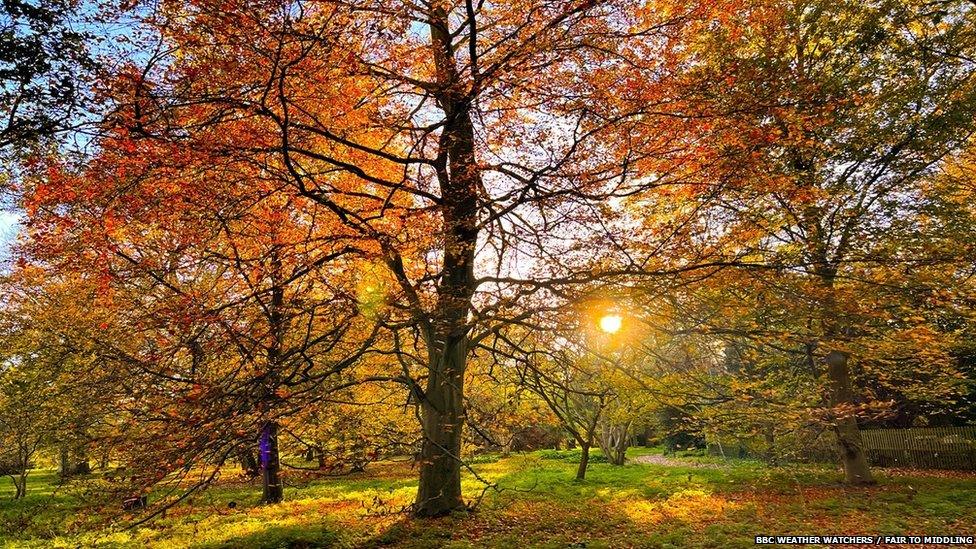Autumn 2022 is officially one of the warmest on record
- Published

You might have noticed a chill in the air since we entered the winter season at the start of December, but autumn 2022 has been confirmed officially as one of the warmest we have had in the UK.
November 2022 itself ended up 1.8C above average, which has made it the third warmest on record, behind only 2006 and 2011, according to the latest statistics from the Met Office.
It was also wetter than average across the UK in November, with some areas such as south-east England and eastern Scotland seeing exceptional amounts of rain.
Warmest year on record so far
We have now gone into a period of drier, colder weather due to the influence of a stubborn area of high pressure sitting over eastern Europe. However, a chilly December is not likely to be enough to knock 2022 off course for becoming the warmest year on record for the UK.
Autumn's weather is the latest in a chain of significant meteorological events this year which included the UK hitting temperatures of more than 40C for the first time.
Thermometers hit 40.3C at Coningsby in Lincolnshire, while 38 other locations exceeded the UK's previous highest temperature of 38.7C, which was set in 2019. The Met Office says temperatures during the first 11 months of 2022 have all been higher than we would normally expect.
Comparison showing the monthly average temperatures for England so far in 2022 and the normal averages
Milder air from the south-west
Looking at November's exceptionally mild conditions, Βι¶ΉΤΌΕΔ Weather's Simon King, said: "Maximum temperatures throughout November normally average 6C to 11C across the UK but we've seen daytime temperatures around 2-3C higher than that.
"South-westerly winds have been dragging much milder air in across the UK and with 21.2 C recorded in Wales in mid-November, we had the highest temperature ever recorded so late in the year."
November nights have also been warm. New highest monthly temperature records were set in Scotland and Northern Ireland, which saw overnight lows of 14.6C and 14.5C respectively on 11th November.
Where was Jack Frost?
There have been a notable lack of air frosts this autumn, despite the chilly end to the season. Air frosts, as the name suggests, are where the air temperature is below freezing. They differ to ground frosts, when you might see a layer on your car in the morning, which happen when the surfaces are freezing but the air temperature can still be 2C to 3C.
Most of south-east England and East Anglia has remained frost-free, and Wisley in Surrey had its first frost-free autumn on record.
Even Santon Downham in Suffolk, a notorious cold spot which would typically have around 10 air frosts in autumn, has only seen two this year.
There have also been fewer frosts in Scotland than normal. Balmoral in Aberdeenshire has seen only nine air frosts this autumn. Since 1930, Balmoral has experienced only two other autumns with fewer than 10 air frosts, with the fewest being eight in 2011.
Exceptional November rainfall brought flooding, such as here in West Sussex
Rainfall record provisionally broken
It was wetter than average for all four nations this autumn and it was the wettest one for the UK as a whole since 2000. That year brought episodes of damaging gales and flooding.
Parts of southern England and north-east Scotland had more than double the average rain fall they would expect. Shoreham Airport in West Sussex, Charlwood in Surrey, and Aboyne and Inverbervie in Aberdeenshire have all had their wettest November on record.
After the drought and hosepipe bans announced for many areas in the summer the above average rainfall in November has helped to improve reservoir levels.
"Second spring"
Horticulturalists have been talking about a "second spring" due to the warmer and wetter conditions, prolonging blooms for months longer than usual. This change could have an impact well into next spring.
Simon King said: "After the hot and dry weather in summer many plants went dormant like they normally would in winter, but then with the wet and mild November there has been a lot of plant growth."
To find out more about the weather predicted for December go to Βι¶ΉΤΌΕΔ Weather's latest Monthly Outlook.
You can follow Βι¶ΉΤΌΕΔ Weather on Twitter @, on Instagram @ and on Βι¶ΉΤΌΕΔ Online.
- Published28 August 2022
- Published8 February
- Published12 November 2022
- Published21 November 2022
- Published14 November 2022